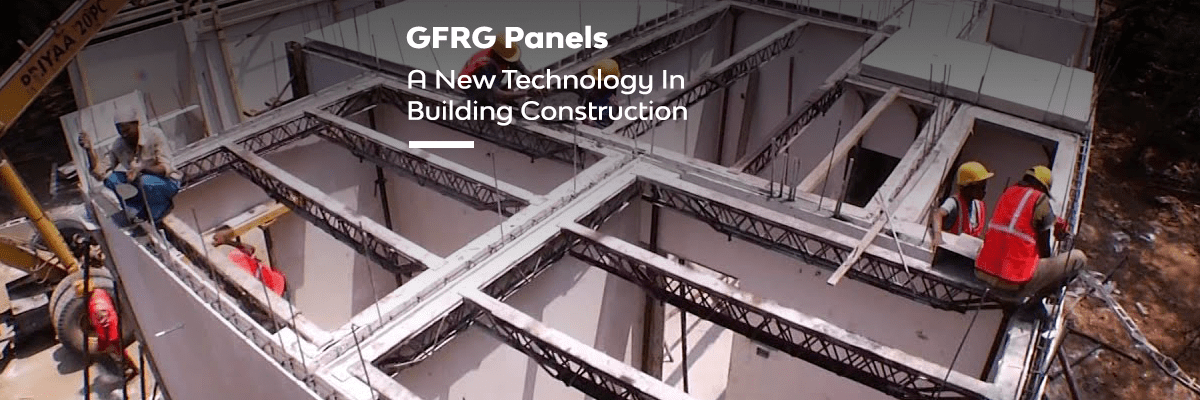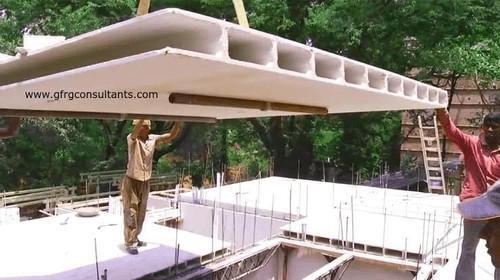In India, the enormous housing demand is causing the exhaustion of raw building materials/sources. Because of this, the cost of building materials is increasing. In this situation, India requires innovative and high-efficiency building materials for strong and durable housing at an affordable cost. Hence, most builders now prefer sustainable solutions like Glass Fibre Reinforced Gypsum (GFRG). If you’re wondering what GFRG means, read on!

Things we covered for you
What is GFRG?
GFRG is an acronym for Glass Fibre Reinforced Gypsum. It is a product that was originally developed and used in Australia in 1990 by Rapid Wall Building Systems.
GFRG panels are a modern trend in rapid building construction technology. These panels are made up of high-strength, resistant, glass fibres bonded with high-density gypsum cement. Presently, this method of construction is broadly accepted by some Asian nations, namely India, China, Saudi Arabia, and Oman.
Why GFRG?
GFRG technology offers several advantages over traditional building materials such as concrete, brick, or wood. GFRG panels are lightweight, fire-resistant, and have a high strength-to-weight ratio, making them ideal for use in earthquake-prone areas or areas with high wind loads.
They are also resistant to moisture and mould, which can be a major problem in traditional building materials. In addition, GFRG panels are prefabricated offsite, which reduces construction time and costs, making them an attractive option for builders and developers.
How does GFRG Technology work?
GFRG (Glass Fiber Reinforced Gypsum) technology involves the use of gypsum panels that are reinforced with glass fibres. These panels are prefabricated off-site and transported to the construction site, where they are assembled to create walls, roofs, and other structural elements of the building.
GFRG panels are manufactured using a special process that involves the mixing of gypsum plaster, water, and glass fibres. The resulting material is then poured into a mould and allowed to dry, creating a lightweight and durable panel that is strong enough to support the weight of the building. The panels can be easily cut to size and shape, allowing for easy customization and flexibility in design.
Is GFRG Panels a government-accepted material for building construction?
Yes, GFRG panels are a government-accepted material for building constructions. Several state governments in India have promoted the use of GFRG technology in their construction projects, citing its many benefits. GFRG panels have been extensively tested and certified by various government agencies and industry bodies, ensuring that they meet the required safety and quality standards.
How does GFRG technology reduce the cost of construction?
GFRG technology can significantly reduce the cost of construction in several ways. Firstly, GFRG panels are prefabricated offsite, reducing the amount of labour and time required for onsite construction.
This can lead to a reduction in overall construction time and cost. Secondly, GFRG panels are lightweight and require less structural support, reducing the amount of steel and cement needed in the construction process. This can lead to a reduction in material costs. Finally, GFRG panels are durable and require less maintenance, reducing the long-term cost of building maintenance.
Is GFRG technology safe? And how long did the GFRG Panels construct house last?
Yes, GFRG technology is safe and has been extensively tested for its structural integrity and fire resistance. GFRG panels are lightweight but have high compressive strength and can withstand high wind loads and earthquakes.
GFRG panels constructed houses can last for several decades with proper maintenance. The panels are durable and resistant to moisture and mould, which can be a major problem in traditional building materials. With proper care, a GFRG panel-constructed house can last for up to 50 years or more.
Step-By-Step Construction Using GFRG Panels
The construction process using GFRG panels involves several steps, including the preparation of the site, the assembly of the panels, and the finishing of the building. Here’s a brief overview of the step-by-step construction process using GFRG panels:
1. Site preparation
The site is prepared by clearing the land and laying the foundation. The foundation is typically constructed using reinforced concrete, and it provides the necessary support for the GFRG panels.
2. Panel assembly
The GFRG panels are prefabricated off-site and transported to the construction site. The panels are then assembled on-site to create the walls, roofs, and other structural elements of the building. The panels are secured in place using a combination of adhesives and mechanical fasteners.
Read: Unleashing the Aesthetics and Benefits of Fibre Ceiling Design
3. Electrical and plumbing work
Electrical and plumbing work is carried out in the building, including the installation of wiring, pipes, and fixtures.
4. Finishing
The building is finished using plaster and paint. This includes the application of a final coat of plaster to the GFRG panels, followed by the application of paint or other finishes to the walls and ceilings.
5. Installation of doors and windows
Doors and windows are installed in the building, including the installation of frames, sills, and hardware.
6. Flooring and tile work
The flooring and tile work is carried out, including the installation of tiles, carpets, or other flooring materials.
7. Final inspection
A final inspection is carried out to ensure that the building meets all safety and quality standards. Any necessary corrections or adjustments are made before the building is deemed complete.
By following these steps, builders and developers can construct buildings using GFRG panels in a safe, cost-effective, and efficient manner.
Read: Top 10 It Companies in Hyderabad
Advantages and Disadvantages of GFRG Panel
Advantages of using the GFRG Panel for houses are listed below:
- High-speed construction: The construction timeline has decreased by 30-40% because the GFRG panels are already manufactured.
- Economical: GFRG decreases the usage of conventional building materials such as cement by almost 50%, steel by 35% and sand by a surprising 76%. This makes it more affordable and convenient for building construction.
- Cooler buildings: Conventional building materials like concrete heats up the building. While GFRG panels can help in keeping the building cooler by up to 4 degrees.
- Increases lifespan: The lifespan of a conventional home is roughly 40-50 years whereas the lifespan of a house built using GFRG panels is around 80-90 years.
- Fire-resistant: In case of fire, GFRG panels release 15-20% moisture of their own weight, which considerably decreases the surface temperature and fire damage.
- Earthquake resistant: GFRG panels have been found to be earthquake resistant. GFRG panels are also used in shear wall construction which is important for high-rise buildings.
- Durability: Gypsum is known for its durability and offers great dimensional stability and strength. GFRG panels are said to be five times stronger and more durable than conventional construction materials.
- Water-resistant: During the GFRG panel manufacturers, several chemicals are added to the mix. Thus, it makes it water-resistant.
- Lightweight: GFRG weighs nearly 1 kg per square foot which is lighter when compared with conventional building materials. Hence, it decreases the load on the supporting beams and pillars of the building.
Disadvantages of GFRG panels
- Stacking: GFRG panels need to be neatly stacked in order to avoid distortion, damage, and abrasion. Hence, it should be stacked vertically on support extending the full length of the panel.
- Handling: The panels are needed to be handled with the utmost care. Movement of the panel must be slow with caution so as to prevent excessive sagging, cracking or damage to a panel at the sides, edges, and corners.
- Cutting: Cutting the GFRG panel should be made with special tools, especially for GFRG panel cutting.
- Delivery: GFRG panels should be handled carefully while loading, transportation, and unloading.
Additionally, ensure the safety and protection of the panels by dodging damages due to collision or collapse of the panels.
Read: Stair Railing Design Marvels: 20 Inspiring Ideas
Applications of GFRG Panels in Building Construction
GFRG panels are a versatile and cost-effective building material that can be used in a variety of applications in building construction. Here are some common applications of GFRG panels:
Read: All You Need to Know About Green Buildings – Factors, Components and More
1. Wall panels
GFRG wall panels can be used as load-bearing or non-load-bearing walls in building construction. They offer excellent fire resistance, acoustic insulation, and durability. GFRG wall panels are lightweight, making them easy to install, and they can be easily customised to suit the design requirements of the building.
2. Roof panels
GFRG roof panels can be used as roofing elements in building construction. They offer excellent thermal insulation, fire resistance, and durability. GFRG roof panels are lightweight, making them easy to install, and they can be easily customised to suit the design requirements of the building.
3. Column covers
GFRG column covers can be used as decorative elements in building construction. They offer excellent durability and resistance to weathering, and they can be easily customised to suit the design requirements of the building.
4. Ceiling panels
GFRG ceiling panels can be used as decorative or functional elements in building construction. They offer excellent acoustic insulation, fire resistance, and durability. GFRG ceiling panels are lightweight, making them easy to install, and they can be easily customised to suit the design requirements of the building.
5. Partition walls
GFRG partition walls can be used as interior walls or compound walls in building construction. They offer excellent fire resistance, acoustic insulation, and durability. GFRG partition walls are lightweight, making them easy to install, and they can be easily customised to suit the design requirements of the building.
6. Decorative elements
GFRG panels can be used as decorative elements in building construction. They can be easily moulded into various shapes and sizes, making them ideal for creating decorative elements such as cornices, mouldings, and medallions.
7. Prefabricated structures
GFRG panels can be used to create prefabricated structures such as modular homes or prefabricated buildings. This offers the advantage of reducing construction time and cost, while also providing a high degree of customization and flexibility in design.
Overall, the versatility, durability, and cost-effectiveness of GFRG panels make them an attractive option for builders and developers in a variety of building construction applications.
Why GFRG? What should you consider before opting for GFRG Panels in India?
Due to their unique characteristics, deciding whether to employ these panels in buildings can be quite difficult. Even though it is a lightweight and durable material, the equipment required for it is unique, which can raise your GFRG panel construction cost per square foot.
Second, if you choose sophisticated and complicated designs, installing such panels becomes even more difficult. Finally, consider how long you intend to use it; GFRG panels have a long life, and you do not want to squander materials on a temporary structure.
The material is light in weight and has an overall flexible strength for housing and business complicated design ideas.
- It has a high load-bearing capacity and is also an environmentally beneficial solution.
- GFRG panels can withstand earthquakes of up to 8 Richter scale.
- These panels are also fireproof, termite-proof, and water-resistant.
- The usage of this material can reduce the weight of the construction’s structural weight.
- It is relatively simple to build and saves time when compared to the usual construction technique.
The GFRG panel construction, new technology in building construction has been proved to be highly efficient in all aspects of construction, particularly in time and cost. Check out the GFRG panel house cost calculator on NoBroker and also save big on home deals and save thousands on brokerage by clicking below.
FAQ’s
Ans. Glass Fiber Reinforced Gypsum (GFRG) Panel is a contemporary building material used to create houses in large numbers quickly. This is a technological advance for the building sector. They have a glazy surface and are primarily white in hue.
Ans. It is an environmentally friendly alternative with a strong load-bearing capacity. Up to an 8-Richter scale earthquake may be withstood by GFRG panels. Additionally, these panels are water-resistant, termite-proof, and fireproof. The weight of the construction’s structural components can be decreased by using this material.
Ans. In order to acquire an estimate for the panels, you might need to utilise, always visit your architect. GFRG panels need a lot of details and design, which might raise building expenses. It must be handled carefully when being transported or loaded because it is fragile due to the fact that it is made of fibre materials.
Ans. When first released in India in 2018, The price of GFRG Panels was about Rs 999 per square metre; however, after 12% GST was included, their current cost is Rs 1120.
Ans. The GFRG panels can withstand earthquakes up to an 8 Richter scale. Additionally, these panels are water-, termite-, and fire-resistant.
Ans. Several GFRG panel manufacturers in India can provide high-quality panels for building construction. NoBroker recommends that you do your research and choose a manufacturer that has a proven track record of delivering high-quality GFRG panels that meet the required safety and quality standards.
Contact NoBroker for more information on GFRG panel manufacturers in India and other building construction-related services. Our experts can provide you with advice and help you make an informed decision.















Hi,
I would also like to know if manufacturing has been started? if started, from when the panels will be available for purchase?
Also, would like to know the current GRFG Panel price.
Thanks,
Rajkumar
Watsapp – +91 9843909390